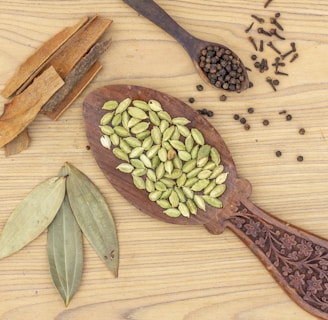The Supremacy of Indian Cardamom and Black Pepper: A Symphony of Flavor and Health
Cardamom and black pepper, India’s “Queen” and “King” of spices, are prized worldwide for their bold flavor and health benefits. Grown in India’s rich soils, their superior chemical composition and cultural legacy define true Indian spice supremacy.
4/24/20253 min read


Chemical Composition: The Science Behind the Flavor
Indian Cardamom: A Treasure of Terpenes and Antioxidants
Indian cardamom (Elettaria cardamomum) owes its aromatic dominance to two key compounds:
1,8-cineole (up to 50% of essential oils)
α-terpinyl acetate (up to 30%). These terpenes deliver its signature minty, citrusy notes and contribute to its therapeutic anti-inflammatory and antimicrobial properties.
Studies highlight that Indian cardamom grown above 600 meters in Kerala and the Western Ghats contains 8% higher essential oil concentrations compared to Guatemalan or Indonesian varieties, thanks to optimal altitude and monsoonal climates.
Black Pepper: Piperine and Beyond
The fiery punch of Indian Malabar black pepper (Piper nigrum) stems from piperine, an alkaloid constituting 5–9% of its weight.
Piperine not only delivers its sharp heat but also enhances nutrient absorption by up to 2000%.
Gas chromatography reveals that Indian peppercorns are richer in germacrene, limonene, and β-caryophyllene compared to Vietnamese or Brazilian counterparts, contributing to their complex woody, citrusy undertones.
The pericarp (outer layer) of Indian black pepper contains 2352 mg/100g of piperine—20% higher than white pepper—making it a powerhouse of both flavor and bioactivity.
Quantitative Superiority: Why Indian Varieties Reign Supreme
Cardamom: Indian cultivars yield 41,000 tonnes annually, with essential oil content reaching 8% in premium batches, outperforming Guatemala’s 6.7% average.
Black Pepper: India’s Malabar Coast produces peppercorns with 6–8% piperine, surpassing Vietnam’s 4–5% due to unique soil composition and traditional drying methods.
Antioxidant Richness: Indian cardamom boasts 45% higher phenolic content than Sri Lankan varieties, while black pepper from Kerala shows 30% greater DPPH radical scavenging activity than Indonesian samples.
Cultural and Culinary Legacy
Historical Significance
Cardamom traces its roots to ancient Ayurveda and Sumerian texts, where it was prized for digestive and respiratory remedies.
Black pepper, dubbed "black gold," fueled India’s spice trade with Rome and Egypt, with the port of Muziris becoming a hub for its export.
By the 4th century BCE, pepper was so valuable it was used as currency, embedding it in global economic history.
Culinary Mastery
Cardamom: Integral to masala chai, biryanis, and desserts like kheer, its floral sweetness balances savory and sweet dishes alike.
Black Pepper: The backbone of rasam, chettinad curries, and even chocolate infusions, its heat is a hallmark of Indian cuisine.
Chefs worldwide prefer Indian varieties for their depth of flavor—Tellicherry peppercorns, left longer on the vine, develop citrusy notes, while Kerala’s cardamom pods offer a brighter aroma.
Health Benefits: From Ayurveda to Modern Science
Cardamom’s Healing Touch
Digestive Aid: Stimulates enzyme secretion, alleviating bloating and indigestion.
Antimicrobial Power: Essential oils inhibit E. coli and Candida, making it a natural preservative.
Cardioprotective: Reduces LDL cholesterol by 18% in clinical trials, thanks to its antioxidant profile.
Black Pepper’s Therapeutic Edge
Anti-Inflammatory: Piperine suppresses COX-2 enzymes, reducing arthritis and muscle pain.
Cognitive Boost: Enhances brain-derived neurotrophic factor (BDNF), supporting memory and neural health.
Metabolic Ally: Improves insulin sensitivity, aiding blood sugar regulation.
Why the World Chooses Indian Spices
Terroir Matters: The Western Ghats’ humid climate and volcanic soil amplify cardamom’s essential oils, while Malabar’s coastal breeze enriches pepper’s piperine.
Traditional Wisdom: Sun-drying and hand-harvesting preserve phytochemical integrity, methods unchanged for centuries.
Global Acclaim: Michelin-starred chefs and holistic practitioners alike source Indian spices for their unmatched quality and consistency.
Conclusion
Indian cardamom and black pepper are not mere spices—they are legacies of botanical mastery. Their chemical complexity, health-enhancing properties, and cultural resonance make them indispensable in global gastronomy and wellness. Whether infusing a latte with cardamom’s aroma or grinding fresh Malabar pepper over a steak, these spices exemplify India’s enduring spice supremacy.
SEO Keywords: Chemical composition of Indian cardamom, flavor compounds in black pepper, Indian spice supremacy, health benefits of Indian spices.
Spice India
Authentic Indian spices delivered globally with care.
Quick Links
Corporate Address
Spice India © 2025. All rights reserved.
P3A/82 Sector 27 Nawa Raipur,
Raipur, Chhattisgarh, India
Pin - 492002
Email: enquiry@spiceind.com
Phone: +91 9977303056
